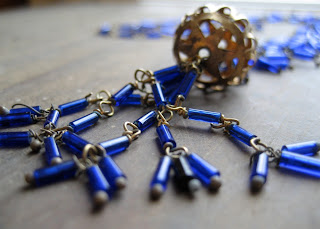






Sooo, I have this mind-boggling necklace now. How it survived 100 years, how it ended up in a case in an antique store off the highway (so close to the highway the building basically shook every time a semi drove by), or how I somehow spotted it buried in a bunch of costume jewelry -- I don't have a clue. I certainly don't deserve it, but . . . I do appreciate it.
It is a 1920s flapper sautoir, made of dozens and dozens of tubular, blue glass beads strung one by one on tiny lengths of brass wire. Each bead has a tiny brass ball at the end to secure it. The first few inches of the necklace (about 7" on either side of the clasp, or about down to the sternum) is just a string of beads, very simple. But THEN the remainder of the necklace has these little clusters of beads spaced all the way down, which makes the piece look fuller and gives it a lot of motion. The focal point of the necklace is a paper-thin, cut-out brass ball that trails a tassel of more beads and bead clusters.
It is so stunning, I literally can't look at it for too long - my brain sort of times-out after about 15 seconds. I am getting flushed just thinking about it.



















































